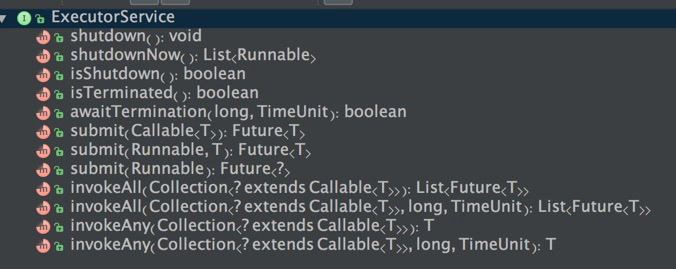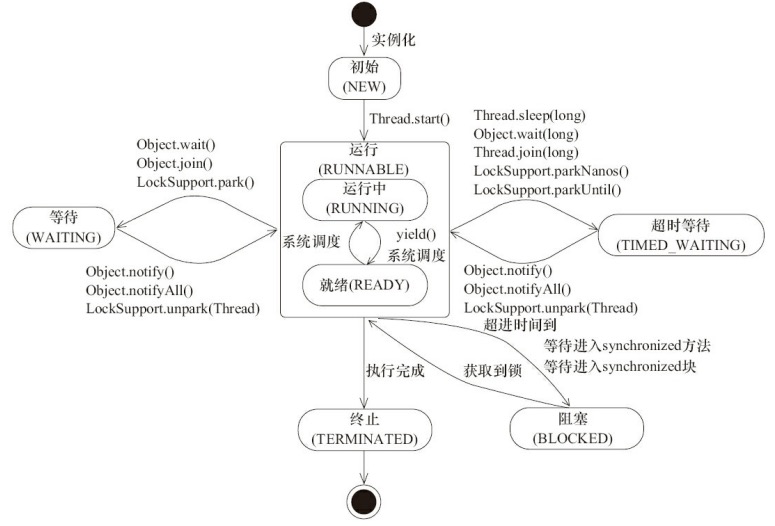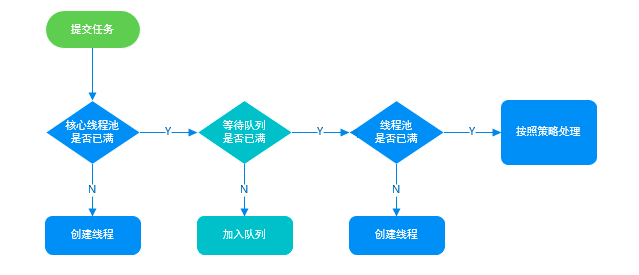ExecutorService
类方法

shutdown 允许已经提交的任务(尚未开始执行和已经开始执行的)继续执行
shutdownNow 尚未开始执行的任务不再执行,同时尝试终止正在执行的任务(调用线程的Thread.interrupt方法)
无论是shutdown 还是shutdownNow,两个的执行都会阻止新的任务提交
一个ExecutorService一旦termination,表明没有正在执行的任务,没有等待执行的任务,也不会有新的任务可以被提交。
如果一个ExecutorService不再使用,应该调用shutdown方法来回收资源。
submit方法(三个重载方法)
返回的Future对象可以用来取消任务和等待任务执行完成 最终内部都调用了execute(runnable)方法来提交任务, 如果传递进来的是callable对象,则会通过适配器模式转换为runnable对象,最后传递给execute方法。invokeAny和invokeAll方法
用户批量执行任务, invokeAny:会阻塞当前线程,直到某个任务完成。并返回这个任务相关的Future对象 invokeAll:会阻塞当前线程,直到所有任务完成。两阶段shutdown
- 先执行shutdown方法
- 调用awaitTermination方法
- 再调用shutdownNow方法
void shutdownAndAwaitTermination(ExecutorService pool) { pool.shutdown(); // Disable new tasks from being submitted try { // Wait a while for existing tasks to terminate if (!pool.awaitTermination(60, TimeUnit.SECONDS)) { pool.shutdownNow(); // Cancel currently executing tasks // Wait a while for tasks to respond to being cancelled if (!pool.awaitTermination(60, TimeUnit.SECONDS)) System.err.println("Pool did not terminate"); } } catch (InterruptedException ie) { // (Re-)Cancel if current thread also interrupted pool.shutdownNow(); // Preserve interrupt status Thread.currentThread().interrupt(); } }isShutdown和isTerminated分别对应于两个状态:关闭状态,终结状态
Thread
interrupt方法 如果执行a.interrupt方法后,如果a线程(注意是a线程,不是调用线程)抛出了InterruptedException异常,那么a的中断状态会被清除。如果不是抛出InterruptedException异常,那么a的中断状态都会被设置(如果是线程a自己调用了a.interrupt方法,那么a不会抛出InterruptedException异常,所以a的中断状态会被设置)。一般情况下如果抛出了InterruptedException异常,则可以在catch块里自己调用下Thread.currentThread().interrupt()方法。
while(!Thread.currentThread().isInterrupted()){ try{ Thread.sleep(1000); }catch(InterruptedException e){ //没有这行代码的话,可能永远不会退出循环 Thread.currentThread().interrupt(); } }如果线程a当前存在中断状态,然后a执行 LockSupport.park()方法,这个方法会立即返回。
interrupted方法 执行a.interrupted方法会返回a线程的中断状态,同时会清除a线程的中断状态
isInterrupted方法 执行a.interrupted方法会返回a线程的中断状态,不会清除a线程的中断状态
join方法 线程b执行a.join方法后,线程b进入WAITING状态,将等待a线程执行完毕,然后b才会继续执行
sleep方法 哪个线程执行的sleep方法就让哪个线程sleep。比如线程b执行a.sleep方法,那么进入sleep的线程并不是a线程,而是b线程。也就是说sleep方法是让执行sleep方法的线程sleep。 Thread.sleep方法==Thread.currentThread().sleep方法
线程状态 在等待池中的线程(指的是sync的实现)的状态不一定是 WAITING 或 TIMED_WATING ,也可能是BLOCKED状态。 当执行notifyAll方法后,会唤醒等待池中的所有线程,此时等待池中所有线程的状态为Runnable,然后这些线程会去竞争锁,没有得到锁的线程将进入BLOCKED状态。
CPU的cas指令并非是把数据的读取,修改,写入三个操作作为一个原子操作。只是在修改前回去比对实际的值和期望的值。某个线程在执行cas操作期间,其他线程仍然可以进行读取和写入。
不是所有CPU都支持CAS,在某些平台,jvm中cas的实现仍然是锁机制
某个线程执行了Unsafe.park方法后,该线程进入WAITING状态。
线程状态 new,runable,waiting,timed-waiting,blocked,terminated

记住:只有sync关键字才会导致线程进入blocked状态
守护线程
- main线程挂了,守护线程跟着挂
- 某个某个线程是守护线程,那么执行路径中的try-finally,finally方法jvm不保证能执行
非守护线程:main线程挂了,非守护线程可以继续执行
notify & wait 标准范式
在Object类的源码中给出了这两个方法的是否范例。
等待方:
1. 获得锁
2. 在循环里判断条件是否满足,不满足则执行wait方法
3. 条件满足跳出循环,执行业务逻辑
sync(obj){
while(!condition){
obj.wait();
}
//do something
}
通知方:
1. 获得锁
2. 改变condition
3. 通知等待方
sync(obj){
condition = true;
obj.notify() // obj.notifyAll();
}
yield()/sleep()/wait()/notify()对锁的有何影响?
- yield方法执行后只会让出cpu,但不会释放锁
- sleep方法也不会释放锁
- 执行wait方法前必须先获得锁,执行后将会释放锁。当wait方法返回后将会重新获得锁
- 执行notify方法前必须先获得锁,执行后不会释放锁
sync的对象不要用String、Integer、Long等基础的对象,因为共享原因可能锁到别人用的值。
ThreadPoolExecutor
public ThreadPoolExecutor(int corePoolSize,
int maximumPoolSize,
long keepAliveTime,
TimeUnit unit,
BlockingQueue<Runnable> workQueue,
ThreadFactory threadFactory,
RejectedExecutionHandler handler)
core pool size 及 max pool size
一个新的任务提交哪些情况下会创建新的线程:(可以结合下面代码中的注释) 1. 当前池中的任务数小于corePoolSize 2. 如果池中的任务数大于corePoolSize小于maxPoolSize,同时任务队列已经满的情况下,也会创建新的线程
可以动态改变这两个的值:setCorePoolSize 以及 setMaximumPoolSize
如果corePoolSize==maximumPoolSize,那么则创建了一个固定大小的线程池
public void execute(Runnable command) {
if (command == null)
throw new NullPointerException();
/*
* Proceed in 3 steps:
*
* 1. If fewer than corePoolSize threads are running, try to
* start a new thread with the given command as its first
* task. The call to addWorker atomically checks runState and
* workerCount, and so prevents false alarms that would add
* threads when it shouldn't, by returning false.
*
* 2. If a task can be successfully queued, then we still need
* to double-check whether we should have added a thread
* (because existing ones died since last checking) or that
* the pool shut down since entry into this method. So we
* recheck state and if necessary roll back the enqueuing if
* stopped, or start a new thread if there are none.
*
* 3. If we cannot queue task, then we try to add a new
* thread. If it fails, we know we are shut down or saturated
* and so reject the task.
*/
int c = ctl.get();
if (workerCountOf(c) < corePoolSize) {
if (addWorker(command, true))
return;
c = ctl.get();
}
if (isRunning(c) && workQueue.offer(command)) {
int recheck = ctl.get();
if (! isRunning(recheck) && remove(command))
reject(command);
else if (workerCountOf(recheck) == 0)
addWorker(null, false);
}
else if (!addWorker(command, false))
reject(command);
}
keep alive time
如果正在运行中的线程大于了corePoolSize,并且如果有线程的空闲时间大于了keepAliveTime,那么这些线程会被kill掉直到剩下corePoolSize个线程。
可以动态设置:setKeepAliveTime方法
默认情况下keep-alive策略只会针对已创建线程数大于corePoolSize的情况下
可以通过执行allowCoreThreadTimeOut(boolean)让keep-alive策略应用在已创建线程数小于corePoolSize的情况下。
BlockingQueue
- 如果当前池中的线程数小于corePoolSize,那么会创建新的线程来执行当前提交的任务,而不是进入阻塞队列
- 如果当前池中的线程数大于等于corePoolSize,会尝试先进入阻塞队列,如果进入失败(其实就是队列已满),则会在maxPoolSize条件下创建新的线程来执行当前提交的任务。 如果不满足maxPoolSize条件,那么就会执行 拒绝执行策略(默认的拒绝执行策略见下)

SynchronousQueue
是一个无缓冲的等待队列,生产入队的时候需要有线程等待消费出队,消费出队的时候必须有线程正要生产入队,否则线程阻塞。
有两种模式
公平模式:使用FIFO队列来阻塞多余的生产者和消费者,从而体系整体的公平策略
非公平模式:使用LIFO队列来管理多余的生产者和消费者,如果生产者和消费者的处理速度有差距,则很容易出现饥渴的情况,即可能有某些生产者或者是消费者的数据永远都得不到处理。
直接传递给线程(Direct handoffs)
感觉可以理解为这个入队列会总是失败,就相当于没有这个队列一样。这样就能在maxPoolSize条件下尽可能快的创建(或选择空闲的线程)来执行新提交的任务。
如果提交的任务有互相的依赖性,可以考虑使用这种队列。
public static ExecutorService newCachedThreadPool() {
return new ThreadPoolExecutor(0, Integer.MAX_VALUE,
60L, TimeUnit.SECONDS,
new SynchronousQueue<Runnable>());
}
这个线程池,如果有洪水般的任务进来,那么就会瞬间创建大量的线程,这是很危险的,所以一般建议不使用这个工厂方法,虽然当任务减少后,线程的个数也会在60秒后一一回收。
LinkedBlockingQueue
基于带头结点的单向链表实现,不过头结点的指向是变动的,一旦new出来则不可扩容。
采用了两个锁(一个用于入队,一个用于出队),所以入队出队两个操作互不影响。两个锁都是非公平锁。
初始化时建议制定一个容量,否则是int的最大值。如果生产者速度比消费者快,可能会消耗大量内存。
ArrayBlockingQueue
基于指定长度的数组实现,不可扩容。维护了两个int型变量,分别执行队首和队尾下标,实现循环数组的效果
由于采用了一个锁,所以在入队操作和出队操作不能同时进行
可以指定采用的锁是否为公平锁,默认情况下为非公平锁
PriorityBlockingQueue
物理上基于数组来实现,逻辑上采用的是堆存储结构,可扩容。put方法采用offer方法实现,所以put方法不会阻塞。
排序算法采用的是堆排序,遍历这个队列并不能得到有序输出,只有依次执行出队操作才能得到有序输出。
使用一个锁来完成
System.out.println(priorityBlockingQueue.offer(4)); System.out.println(priorityBlockingQueue.offer(8)); System.out.println(priorityBlockingQueue.offer(1)); Iterator iterator = priorityBlockingQueue.iterator(); while (iterator.hasNext()) { System.out.println(iterator.next()); } //输出:1,8,4 System.out.println(); # 会发现并非按照1,4,8的顺序输出。但下面的就是就是按照 1,4,8的顺序输出 while (true) { try { System.out.println(priorityBlockingQueue.take()); } catch (InterruptedException e) { e.printStackTrace(); } } //输出:1,4,8 # 但这个队列会保证队列的第一个元素永远是当前优先级最高的元素要求要么元素实现了Comparable接口,要么这个队列有一个Comparator实例
拒绝执行策略

ThreadPoolExecutor.AbortPolicy
抛出RejectedExecutionException异常
public void rejectedExecution(Runnable r, ThreadPoolExecutor e) {
throw new RejectedExecutionException("Task " + r.toString() +
" rejected from " +
e.toString());
}
ThreadPoolExecutor.CallerRunsPolicy
在调用线程上执行(哪个线程提交的任务就哪个线程执行)
public void rejectedExecution(Runnable r, ThreadPoolExecutor e) {
if (!e.isShutdown()) {
r.run();
}
}
ThreadPoolExecutor.DiscardPolicy
直接放弃
public void rejectedExecution(Runnable r, ThreadPoolExecutor e) {
}
ThreadPoolExecutor.DiscardOldestPolicy
放弃当前队列中第一个任务
public void rejectedExecution(Runnable r, ThreadPoolExecutor e) {
if (!e.isShutdown()) {
e.getQueue().poll();
e.execute(r);
}
}
Finalization
一个在程序中不再被引用的线程池如果同时没有剩余的线程,那么这个线程池会被自动的shutdown.
因此如果你想即便在忘记执行shutdown方法的时候仍能正常关闭线程池,那么建议设置一个有限的keepAliveTime(针对大于线程数大于corePoolSize的那些线程),同时也执行下 allowCoreThreadTimeOut(boolean) .
系统推荐
- MySQL常用命令
- 是时候使用MapStruct替代BeanUtils了
- MongoDB高可用
- IO相关
- 乱七八糟的笔记
- 异地多活
- Arthas使用记录
- Java面试基础
- CentOS7下Docker端口映射后防火墙失效
- 批量替换文件名中的指定字符串
- vuepress-theme-hope 添加谷歌广告
- intro
- 随机毒鸡汤:不是理想太不现实,而是现实太不理想。

